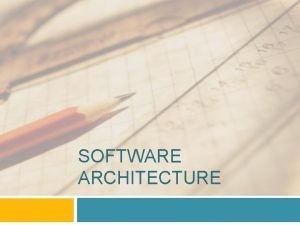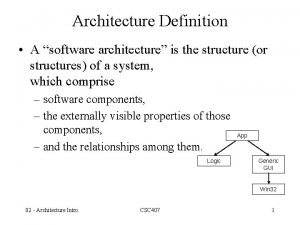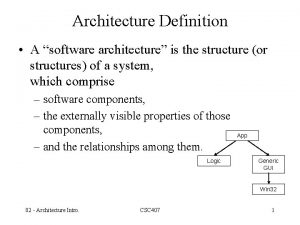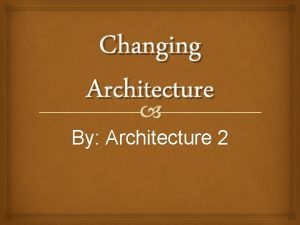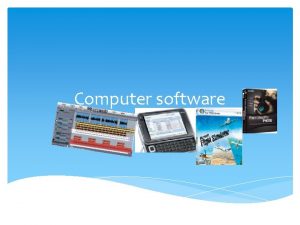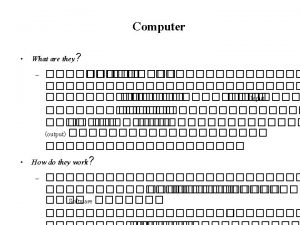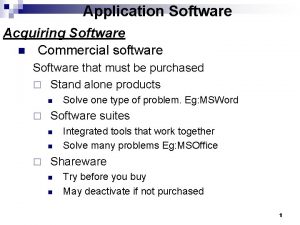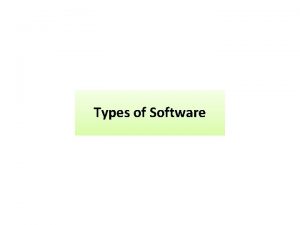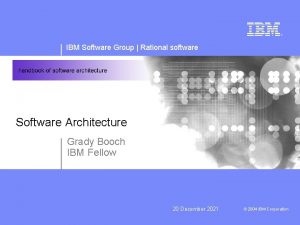Architecture Definition A software architecture is the structure

























- Slides: 25

Architecture Definition • A “software architecture” is the structure (or structures) of a system, which comprise – software components, – the externally visible properties of those components, – and the relationships among them. Logic App Generic GUI Win 32 02 - Architecture Intro. CSC 407 1

Components & Structures • Architecture defines “components” – an abstraction – suppresses details not pertinent to its interactions with other components • An architecture comprises more than one structure • modular structure (calls/uses) • process structure (invokes, communicates with, synchronises with) • physical structure (libraries, DLL’s, processors) • inheritance structures (inherits) • … 02 - Architecture Intro. CSC 407 2

In Practice • Divide into two levels: – System-Level Architecture – Programming-Level Design [User Interface – Sometimes also referred to as “design” (or even “architecture”) – Different topic. Not covered in this course. ] 02 - Architecture Intro. CSC 407 3

Design & Architecture in the Development Process Requirements Architecture Design Code & Unit Test C&ut Design C&ut Integration Test System Test 02 - Architecture Intro. CSC 407 4

Software Architecture • Specifying at the highest level the construction of the system: – Technology choices • Platforms, language, database, middleware, … – System construction • Overall pattern: Monolithic, RDBMS, client/server, 3 -tiered, ntiered, distributed, … • Hardware interfaces (if any) – Division into programs • E. g. a program for data entry, another for data analysis, a Weboriented interface, … – Division of programs into major subsystems • Reuse strategy (shared subsystems) • Calls constraints • Major strategies (e. g. , for persistence, IPC, …) 02 - Architecture Intro. CSC 407 5

Software Design • We are now considering how to lay down code. • E. g. , Object-Oriented – What classes? What inheritance amongst the classes? – What classes will call what other classes? – How are classes grouped into subsystems (e. g. Java packages)? – What data members of classes • Must decide these things at some point during the coding process. – Wish to minimize re-writes now and down the line – Danger in early over-complexity (c. f. Extreme Programming) 02 - Architecture Intro. CSC 407 6

Architecture & Design • Architecture – High-level – Major decisions – Not even thinking about programming • Design – “Laying out” the programming language code used to implement the architecture – Organizing programming language concepts But, … N. B. no standard terminology 02 - Architecture Intro. CSC 407 7

Documentation of an Architecture • Golden Rule of Software Development: – If it’s not reviewable (written down), it doesn’t exist. • Architectures sometime suffer from over-elaborate documentation – Unnecessary. Simply document your decisions. – Most systems don’t deserve elaborate architectural documentation • Dealing with unknowns – Indicate they are unknown for the present – Cycle back later and add new decisions taken – But beware of costs of postponing decisions • Must religiously keep architecture document up-to-date – Very hard to do in practice: takes effort – Therefore keep it simple as possible (but no simpler) 02 - Architecture Intro. CSC 407 8

How do we describe an architecture? Control Process (CP) Prop Loss Model (MODP) Reverb Model (MODR) Noise Model (MODN) • • What is the nature of the components? What is the nature of the links? Does the layout have any significance? How does it operate at runtime – Dataflow – Control flow • Can we evaluate this architecture? 02 - Architecture Intro. CSC 407 9

Two Main Architectural Structures • Modular structure – Purely static – Disappears at run-time • Structures that survive through execution – E. g. , pipes, processes, networks, objects, … • Both views need to be considered (not the same) 02 - Architecture Intro. CSC 407 10

The Essence of the Architecture Document • Imagine after the system has been built attempting to describe as cogently and in as compact a form as possible how the system has been put together. • Be utterly clear • you only have an hour in which to do it. • your target audience is knowledgeable professionals in the field, but unfamiliar with the domain. • They will wish to evaluate your choices 02 - Architecture Intro. CSC 407 11

Documentation of a Design • UML (Unified Modeling Language) – Expresses OO design using diagrammatic notation – Complete UML for a typical system is very large. – A selection must be made for presentation • • Choose the most illuminating parts Simplify w. r. t. the actual code Divide into small sections (< 1 page) Add written text to describe the whys and wherefores. • Danger of UML and code getting out of synch over time – Automated tools to keep the two in-synch • E. g. , Rational Rose – Problem with these tools: • • Not literate Don’t work as well as we would want, cumbersome to use Eliding detail is difficult, simplifying (lying) is difficult Selection of parts for presentation is primitive • Strive to explain (in writing) your choices to another programmer 02 - Architecture Intro. CSC 407 12

Documentation • Architecture – Informal diagrams – Written explanations – Bullet points • Design – Formal UML – Reflects and in-synch with program structure – Simplify and divide into small chunks for presentation – Add written explanations. 02 - Architecture Intro. CSC 407 13

The Waterfall Model • Requirements → Architecture → Design → Code → Test – Variations: Spiral, prototyping, … • All will have architecture and design artefacts • Dave Parnas: “A Rational Design Process: How and when to fake it” – Not important that the steps are followed in this order – Only important that after the fact, there are documents that make it appear as though the process was followed in that order. 02 - Architecture Intro. CSC 407 14

Documentation In Practice • As much requirements as you can manage without getting bogged down. • As much architecture as you can manage without getting bogged down • Some design • Some code • More design • More code • Refine architecture • Fix requirements • … 02 - Architecture Intro. CSC 407 15

Why is architecture important? • Manifests early design decision – most difficult to get correct and hardest to change – defines constraints on the implementation – inhibits or enables quality attributes • Defines a work-breakdown structure – organization (especially important for long-distance development) – estimation • A vehicle for stakeholder communication – an architecture is the earliest artefact that enables the priorities among competing concerns to be analysed • Reviewable – architectural errors are vastly more expensive to fix once a system has been coded – Can serve as a basis for training new developers – As an indication of progress 02 - Architecture Intro. CSC 407 16

Why is design important? • When dealing with ~100 s of packages and ~1000 s of classes, coders lose sight of the forest for the trees. – Leads to designs that are muddled and inconsistent • Buggy, requiring constant re-work • Long learning curve for new developers • Hard to fix bugs – Long time to debug, lots of code to fix, introduce new bugs • Hard to change – Lots of time to figure out how to change, lots of code to change, introduce lots of new bugs • Higher-level design descriptions lead to better designs – Can grasp the design at its essence and in its entirety – Can review and correct early • Can be used to leverage the skills and experience of better designers across many developers 02 - Architecture Intro. CSC 407 17

Where does architecture come from? Developing organization Customers Marketing End Users Current technical environment previous experience Architect 02 - Architecture Intro. CSC 407 18

What does architecture affect? – The structure of the developing organisation – The enterprise goals of the developing organisation – customer requirements for the next system – influence later architectural decisions 02 - Architecture Intro. CSC 407 19

Architecture process steps • • • create the business case understand the requirements create the architecture represent and communicate the architecture evaluate the architecture implement based on the architecture – ensuring conformance • enhance/maintain based on the architecture – ensuring conformance 02 - Architecture Intro. CSC 407 20

Functionality & Quality Attributes • Functionality usually takes 1 st place during development. • Systems are more frequently re-designed not because they are functionally deficient, but rather because – – – They are difficult to maintain Difficult to port Won’t scale Too slow Too insecure Not fault tolerant 02 - Architecture Intro. CSC 407 21

System Qualities • Observable via execution – Performance – Security – Availability • Reliability = mttf = mean time to failure • Availability = mttf/(mttf + time to repair) – Functionality – Usability • Not observable via execution – – – Modifiability Portability Reusability Integrability Testability 02 - Architecture Intro. CSC 407 22

Business Qualities – Time-to-market – Cost – Projected lifetime – Target market – Rollout schedule – Use of legacy systems 02 - Architecture Intro. CSC 407 23

Architectural Qualities • • Conceptual integrity Correctness Completeness Buildability – Completed by available team in a timely manner 02 - Architecture Intro. CSC 407 24

Architectural Means of Achieving Quality • Two questions – What structure shall I employ to • • Assign workers Derive a work breakdown Exploit pre-packaged components Plan for modification – What structure shall I employ so that the system, at runtime, fulfills its behavioral and quality attributes. 02 - Architecture Intro. CSC 407 25
 Architecture business cycle activities
Architecture business cycle activities Call and return architecture
Call and return architecture Hình ảnh bộ gõ cơ thể búng tay
Hình ảnh bộ gõ cơ thể búng tay Slidetodoc
Slidetodoc Bổ thể
Bổ thể Tỉ lệ cơ thể trẻ em
Tỉ lệ cơ thể trẻ em Chó sói
Chó sói Glasgow thang điểm
Glasgow thang điểm Chúa yêu trần thế
Chúa yêu trần thế Các môn thể thao bắt đầu bằng tiếng nhảy
Các môn thể thao bắt đầu bằng tiếng nhảy Thế nào là hệ số cao nhất
Thế nào là hệ số cao nhất Các châu lục và đại dương trên thế giới
Các châu lục và đại dương trên thế giới Công thức tiính động năng
Công thức tiính động năng Trời xanh đây là của chúng ta thể thơ
Trời xanh đây là của chúng ta thể thơ Mật thư anh em như thể tay chân
Mật thư anh em như thể tay chân Phép trừ bù
Phép trừ bù Phản ứng thế ankan
Phản ứng thế ankan Các châu lục và đại dương trên thế giới
Các châu lục và đại dương trên thế giới Thơ thất ngôn tứ tuyệt đường luật
Thơ thất ngôn tứ tuyệt đường luật Quá trình desamine hóa có thể tạo ra
Quá trình desamine hóa có thể tạo ra Một số thể thơ truyền thống
Một số thể thơ truyền thống Cái miệng nó xinh thế chỉ nói điều hay thôi
Cái miệng nó xinh thế chỉ nói điều hay thôi Vẽ hình chiếu vuông góc của vật thể sau
Vẽ hình chiếu vuông góc của vật thể sau Biện pháp chống mỏi cơ
Biện pháp chống mỏi cơ đặc điểm cơ thể của người tối cổ
đặc điểm cơ thể của người tối cổ Ví dụ về giọng cùng tên
Ví dụ về giọng cùng tên


























